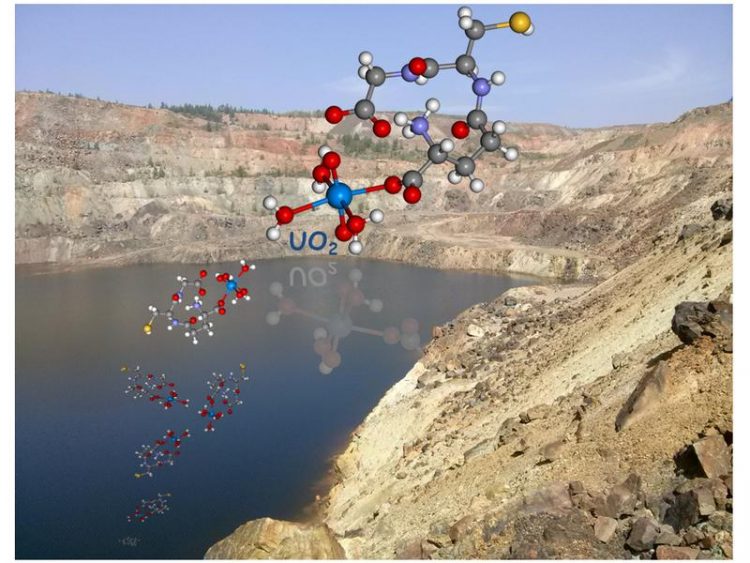A Protective Shield against the Heavy Metal Uranium

If uranium is built into the molecule glutathione, the chemical toxicity of the heavy metal decreases. HZDR / Karim Fahmy
Living cells are small power stations in which various chemical reactions take place, releasing tiny amounts of heat. Metabolism is stimulated when the cells are exposed to uranium, without, however, leading to increased growth.
This extra effort is detectable in the organisms as increased heat emission – signaling their fight against the toxin. The four-person team from Dresden and Bern (Dr. Muhammad H. Obeid, Dr. Jana Oertel, Prof. Marc Solioz, Prof. Karim Fahmy) established a highly sensitive method, known as microcalorimetry, with which this power can be measured – even if it lies only in the microwatt (a millionth of a watt) range.
Through their tests, the researchers furthermore determine the culture cell count and thus register how the cells divide and grow. Karim Fahmy summarizes the results: “We have found out that the metabolism with uranium becomes less efficient. The cells produce more heat but not more cells. They’re virtually running a temperature!”
The organisms clearly use their energy for defense mechanisms rather than for growth. A completely different picture emerges when glutathione is present. In this case, the cells continue to grow. “Glutathione lowers uranium’s chemical toxicity. The cells better withstand the contamination,” says the biophysicist.
A bacterium from cheese production, Lactococcus lactis, was chosen for the studies. The researchers used a strain with an artificially introduced hereditary predisposition for glutathione production. The gene can be selectively switched on or off. This allows precise control of whether the cells produce glutathione or not. Karim Fahmy explains, “We thereby have a clean model and do not need to add the glutathione from the outside.” Disruptive factors are thus excluded.
These new insights on the protective effects of glutathione are important for innovative strategies in biological heavy metal decontamination in the environment. The process known as bioremediation attempts to harness plants or bacteria for the removal of toxins from contaminated sites. The organisms absorb the contaminants, which are removed from the site under controlled conditions through a subsequent “harvest”. The procedure also appears suitable for uranium decontamination. As is clear from the HZDR researchers’ findings, a preference should be given to organisms with their own glutathione biosynthesis.
Glutathione has already been discussed for quite a long time as a decontaminant because it is an antioxidant and, for example, renders free radicals harmless. Until now, however, strong proof of its protective effects against uranium has been lacking. The Dresden researchers have now made up for this lack. The results are particularly significant because they were obtained from living organisms.
An insoluble and therefore non-toxic complex
The researchers could also gain further insights on how the interaction between heavy metals and glutathione works. Karim Fahmy says, “We see that uranium binds to the carboxyl group of glutathione. This results in an insoluble complex that is no longer toxic.” This applies to the concentrations studied, 10 to 150 micromolar uranium – a content which is typically found at contaminated sites in the German Ore Mountains. Comparative measurements showed that for copper, entirely different reactions occur within the cells. Glutathione fails to deploy any protective effects here.
Measuring metabolic warming for environmentally relevant risk evaluation of heavy metals is intensely promoted at the Institute of Resource Ecology at the HZDR. The unique opportunity to also work with radioactive materials at the institute results in entirely new insights on the effects of low concentrations of radionuclides in organisms, relevant in the fields of medicine and environmental biology.
Publication: Muhammad H. Obeid, Jana Oertel, Marc Solioz, Karim Fahmy, „Mechanism of attenuation of uranyl toxicity by glutathione in Lactococcus lactis“, in: Applied and Environmental Microbiology, June 2016 (doi:10.1128/AEM.00538-16)
Further information:
Prof. Dr. Karim Fahmy
Institute of Ressource Ecology at the HZDR
Phone +49 0351 260-2952 | Email k.fahmy@hzdr.de
Media contact:
Christine Bohnet | Press spokesperson
Phone +49 351 260-2450 | Email c.bohnet@hzdr.de
Helmholtz-Zentrum Dresden-Rossendorf | Bautzner Landstr. 400 | 01328 Dresden, Germany | www.hzdr.de
The Helmholtz-Zentrum Dresden-Rossendorf (HZDR) conducts research in the sectors energy, health, and matter. It focuses its research on the following topics:
• How can energy and resources be used efficiently, safely, and sustainably?
• How can malignant tumors be visualized and characterized more precisely and treated effectively?
• How do matter and materials behave in strong fields and in the smallest dimensions?
The HZDR has been a member of the Helmholtz Association, Germany’s largest research organization, since 2011. It has four locations (Dresden, Leipzig, Freiberg, Grenoble) and employs about 1,100 people – approximately 500 of whom are scientists, including 150 doctoral candidates.
Media Contact
All latest news from the category: Life Sciences and Chemistry
Articles and reports from the Life Sciences and chemistry area deal with applied and basic research into modern biology, chemistry and human medicine.
Valuable information can be found on a range of life sciences fields including bacteriology, biochemistry, bionics, bioinformatics, biophysics, biotechnology, genetics, geobotany, human biology, marine biology, microbiology, molecular biology, cellular biology, zoology, bioinorganic chemistry, microchemistry and environmental chemistry.
Newest articles

First-of-its-kind study uses remote sensing to monitor plastic debris in rivers and lakes
Remote sensing creates a cost-effective solution to monitoring plastic pollution. A first-of-its-kind study from researchers at the University of Minnesota Twin Cities shows how remote sensing can help monitor and…

Laser-based artificial neuron mimics nerve cell functions at lightning speed
With a processing speed a billion times faster than nature, chip-based laser neuron could help advance AI tasks such as pattern recognition and sequence prediction. Researchers have developed a laser-based…

Optimising the processing of plastic waste
Just one look in the yellow bin reveals a colourful jumble of different types of plastic. However, the purer and more uniform plastic waste is, the easier it is to…



